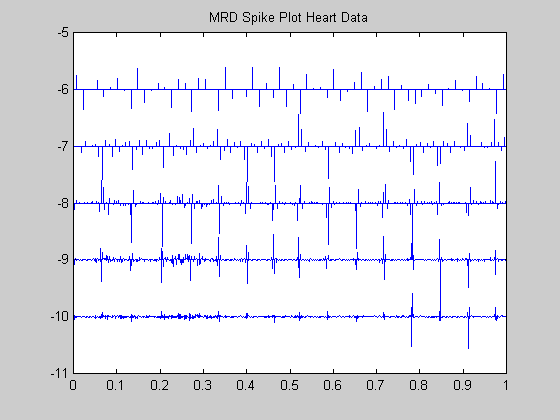Analysis of the Heart Data Set
%input the data and plot the time series
heart=dlmread('heart.dat');
plot(1:2048, heart, '-')
%look at help for the functions we need
help MakeONFilter
help FWT_PO
help PlotMultiRes
MakeONFilter -- Generate Orthonormal QMF Filter for Wavelet Transform
Usage
qmf = MakeONFilter(Type,Par)
Inputs
Type string, 'Haar', 'Beylkin', 'Coiflet', 'Daubechies',
'Symmlet', 'Vaidyanathan','Battle'
Par integer, it is a parameter related to the support and vanishing
moments of the wavelets, explained below for each wavelet.
Outputs
qmf quadrature mirror filter
Description
The Haar filter (which could be considered a Daubechies-2) was the
first wavelet, though not called as such, and is discontinuous.
The Beylkin filter places roots for the frequency response function
close to the Nyquist frequency on the real axis.
The Coiflet filters are designed to give both the mother and father
wavelets 2*Par vanishing moments; here Par may be one of 1,2,3,4 or 5.
The Daubechies filters are minimal phase filters that generate wavelets
which have a minimal support for a given number of vanishing moments.
They are indexed by their length, Par, which may be one of
4,6,8,10,12,14,16,18 or 20. The number of vanishing moments is par/2.
Symmlets are also wavelets within a minimum size support for a given
number of vanishing moments, but they are as symmetrical as possible,
as opposed to the Daubechies filters which are highly asymmetrical.
They are indexed by Par, which specifies the number of vanishing
moments and is equal to half the size of the support. It ranges
from 4 to 10.
The Vaidyanathan filter gives an exact reconstruction, but does not
satisfy any moment condition. The filter has been optimized for
speech coding.
The Battle-Lemarie filter generate spline orthogonal wavelet basis.
The parameter Par gives the degree of the spline. The number of
vanishing moments is Par+1.
See Also
FWT_PO, IWT_PO, FWT2_PO, IWT2_PO, WPAnalysis
References
The books by Daubechies and Wickerhauser.
FWT_PO -- Forward Wavelet Transform (periodized, orthogonal)
Usage
wc = FWT_PO(x,L,qmf)
Inputs
x 1-d signal; length(x) = 2^J
L Coarsest Level of V_0; L << J
qmf quadrature mirror filter (orthonormal)
Outputs
wc 1-d wavelet transform of x.
Description
1. qmf filter may be obtained from MakeONFilter
2. usually, length(qmf) < 2^(L+1)
3. To reconstruct use IWT_PO
See Also
IWT_PO, MakeONFilter
PlotMultiRes -- Multi-Resolution Display of 1-d Wavelet Transform
Usage
PlotMultiRes(wc,L,scal,qmf)
Inputs
wc 1-d wavelet transform
L level of coarsest scale
scal scale factor [0 ==> autoscale]
qmf quadrature mirror filter used to make wc
Side Effects
A depiction of the multi-resolution decomposition
of the signal, as in S. Mallat.
See Also
PlotWaveCoeff, FWT_PO, IWT_PO, MakeONFilter
%Use Symmlet 4 (Same as LA8) and J0=6
qmf = MakeONFilter('Symmlet', 8);
wc = FWT_PO(heart,6,qmf);
PlotMultiRes(wc,6,0,qmf);
title('MRA Heart Data')

Spike-plot display of wavelet coefficients
PlotWaveCoeff(wc,6,0);
title('MRD Spike Plot Heart Data')

Now we look at the MODWT MRA Analysis
help FWT_Stat
help PlotStatTable
wc = FWT_Stat(heart, 6, qmf);
PlotStatTable(wc,0);
title('MRA Heart Data: MODWT')
FWT_Stat -- stationary wavelet transform
Usage
StatWT = FWT_Stat(x,D,qmf)
Inputs
x array of dyadic length n=2^J
L degree of coarsest scale
qmf orthonormal quadrature mirror filter
Outputs
StatWT stationary wavelet transform table
formally same data structure as packet table
log_2(n)-D scales by n elements
See Also
IWT_Stat, FWT_TI
PlotStatTable -- Plot Stationary Wavelet Transform
Usage
PlotStatTable(StatWT,scal)
Inputs
StatWT 1-d stationary wavelet transform
scal optional scale factor [0 ==> autoscale]
Side Effects
A depiction of the stationary wavelet transform,
much like multi-resolution decomposition
of signal
See Also
PlotMultiRes, FWT_Stat, IWT_Stat




